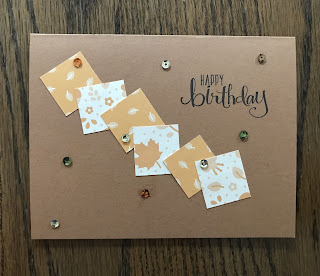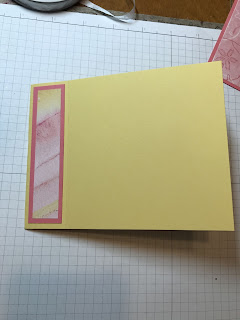Card A : The two rectangles are about 1/4 inch separated under the strip of DSP.
Wednesday, July 21, 2021
One Sheet Wonder #3
This is the third of my one sheet wonder designs.
Here are three clean and simple cards I made using this template.
Card A : The two rectangles are about 1/4 inch separated under the strip of DSP.
One Sheet Wonder #2
This is the second of my one sheet wonder templates for 6 x 6 inch square of Designer Series Paper.
I made two cards using this template. I wasn’t crazy about this sheet of DSP but I really love these cards.This is the template. Cut the paper at 3 3/4 first. If the is an up and down to the pattern be aware of how it will look on the care front. You can make the cards landscape or portrait to accommodate how the paper was cut.
Cut 1 inch from the narrow end of the large rectangle. This will give you a 3 3/4 x 5 inch rectangle for the card front and a 3 3/4 x 1 inch rectangle for a contrasting band.
The 2 x 6 rectangle can be used to cover the envelope flap or can be used for a second card. Here I opted to make the second card.
Card A- Place the 5 x 3 3/4 piece on the card front. Add the 1 x 3 3/4 piece and flip it to the other design. Glue it across the middle of the card front to create a contrasting band. Add sentiment of your choice.
Card B- I lace the 2 inch strip along the fold of the card stock. This can be turned landscape or portrait layout, whichever you like with your DSP.
These cards can be stepped up by adding mats, adding ribbons, using embossing folders, etc.
One Sheet Wonder #1
This is a one sheet wonder for a 6 x 6 inch square of Designer Series Paper.
This is template #1. I made these 3 cards using this template.Here are the three cards I made. They are clean and simple cut you can dress them up using mats, ribbons, embellishments, fussy cuts, embossing folders, etc.
Card A - arrange three of the rectangles randomly on the card front. Add a sentiment and embellishments.
Card B - arrange three of the rectangles on the card front in a straight line. I usually try to pull out three pieces that were side by side to make a continuous design but with the polka dots that doesn’t really matter.
Card A - arrange three of the rectangles randomly on the card front. Add a sentiment and embellishments.
Card B - arrange three of the rectangles on the card front in a straight line. I usually try to pull out three pieces that were side by side to make a continuous design but with the polka dots that doesn’t really matter.
Monday, June 21, 2021
Matchbook Cards
Matchbook cards
Decorate as desired with DSP, ribbon, embellishments, etc. I cut a strip of DSP 1/2 x 4 and added it on the flap.
Coordinating DSP cut 4 x 4 3/4 added to the front. Ribbon and sentiment with an enamel dot was added to the front.
These are so quick and easy.
Thursday, June 10, 2021
Double sided images
I love the animals in A Little Wild but feels wasteful using two images glued back to back when I could just as well stamp on both sides and get 2 double sided images instead on just 1. (sometimes you need two glued together because you are putting something between them but most times I don’t need that).
So I figured out a way to use my stamparatus to stamp on both front and back easily.
I took a piece of scrap basic white - doesn’t matter that it has some ink smudges on one side. This is just my
I taped it down using post-it tape and marked the corners so I can place it back in the exact same spot later.
Die cut the image. Tape the outline to the stamparatus in the same position as earlier.
Place the cut out image face down in the template. Notice the little circle tab is on the right side now.
Stamp the image on the backside. The one on the right didn’t stamp clearly but I could have stamped it again since I’m using the stamparatus.
Just cut apart and trim off the tab and you have 2 double sided elephants.
Don’t throw out the template. Store it with the stamp set and/or dies and you can use it over snd over. Here I did a second set on gray card stock.
Friday, January 29, 2021
Book fold
Card stock #2 - 4 x 4 inches and 4 x 1 inches
DSP #1 - 3 3/4 x 3 3/4 inches
DSP #2 - 3 3/4 x 3/4 inches
Coordinating ribbon
Scraps for sentiment
Score the card base at 4 1/4 and 5 1/2 inches.
Mount DSP on the pieces of card stock.
Adhere narrow strip to the 1 1/4 section on the left side.
Wrap ribbon around front and attach bottom inside.
Subscribe to:
Comments (Atom)



































